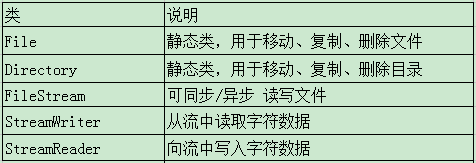流无处不在,只要是关于到文件的输入、输出、更新等,关于IO流,项目中还是经常用到的,写log日志免不了要与其打交道,现在需要用到,就顺道好好回顾一下进行整理,首先是几个需要用到的类的说明,其实说简单点,就是对文件夹、文件、文件内容进行编辑。
1. 创建文件、文件夹
public void OperationFile() { //创建文件 if (!File.Exists("Log.txt")) { File.Create("Log.txt"); } //创建文件夹 if (!Directory.Exists("Log")) { Directory.CreateDirectory("Log"); } }
2. 读写数据到文件中
FileStream 原始,比较复杂,处理的数据多
读取文件数据
public void ReadFileStream() { //打开数据 //FileStream fs = File.OpenRead("201704191450.txt"); //FileInfo fileinfo = new FileInfo("201704191450.txt"); //FileStream fs = fileinfo.OpenRead(); //读取数据 byte[] bytedata = new byte[100]; char[] chardata = new char[100]; FileStream ffs = new FileStream("TestRead.txt",FileMode.Open); //执行文件指针位置 ffs.Seek(10,SeekOrigin.Begin); //读取数据,其起始位置为seek指定的指针位置末 ffs.Read(bytedata,0,100); //设置转码格式 Decoder d = Encoding.UTF8.GetDecoder(); d.GetChars(bytedata,0,bytedata.Length,chardata,0); Console.WriteLine(chardata); Console.ReadKey(); }
写入文件数据
public void WriteFileStream() { //写入数据 byte[] byteData = new byte[100]; char[] charData = new char[100]; FileStream fis = new FileStream("TestWrite.txt", FileMode.Create); charData = ("This is a jokey").ToArray(); byteData = new byte[charData.Length]; Encoder e = Encoding.UTF8.GetEncoder(); e.GetBytes(charData, 0, charData.Length, byteData, 0, true); fis.Seek(0, SeekOrigin.Begin); fis.Write(byteData, 0, byteData.Length); }
由此可见,操作字符数据比较麻烦。而StreamWritrer、StreamReader不需要设置指针位置,读写文件时,比较灵活
StreamReader读取文件数据
////// StreamReader读取日志 /// public void ReadLog() { StreamReader sr = new StreamReader("201704191451.txt", true); string line = sr.ReadLine(); while (line!=null) { Console.WriteLine(line); line = sr.ReadLine(); } sr.Close(); }
StreamWriter写入文件数据
////// StreamWrite写入日志 /// /// public void WriteExLog(string ex) { StreamWriter sw = new StreamWriter(DateTime.Now.ToString("yyyyMMddHHmm")+".txt",true); sw.WriteLine(DateTime.Now.ToString("G")+" "+ex); sw.Close(); }
两者一进行对比,可见StreamWriter、StreamReader确实比FileStream方便很多
关于流文件的使用,上面仅仅是单一的操作,实际项目中,多为混合模式,各种判断柔和在一起,这里也不多说什么,先写一个相对来书综合点的方法
public void OperationStream() { //当前Debug下+创建文件夹 string straddrsfile = AppDomain.CurrentDomain.BaseDirectory + Path.DirectorySeparatorChar.ToString() + "Test1"; //当前路径+文件名 string straddrspath = straddrsfile + Path.DirectorySeparatorChar.ToString() + "Test1" + DateTime.Now.ToString("yyyyMMddHHmmss") + ".xml"; straddrspath = straddrspath.Replace("\\", "/"); if (!File.Exists(straddrsfile)) { //创建文件夹 Directory.CreateDirectory(straddrsfile); //创建文件 StreamWriter sw = new StreamWriter(straddrspath,true); //写入数据 sw.WriteLine(DateTime.Now.ToString("G") + "This is a jokey"); sw.Close(); //读取数据 StreamReader sr = new StreamReader(straddrspath,true); string line = sr.ReadLine(); //输出数据 while (line != null) { Console.WriteLine(line); line = sr.ReadLine(); } sr.Close(); Console.ReadKey(); } }
对于这些流关联的类,其重载的方法有很多,向那些参数的说明,指尖敲击下键盘,点下联想看看说明,就出来,总之,深入的研究清一个问题需要大量的时间,结果还未可知,当前项目既然需要这个日志,就稍稍巩固下。
------分割线---------------
实战:现在接手的项目中需要异常日志,初步思路如下:
//記錄異常日誌 Log file txt public void WriteTxtLog(Exception ex,string sysCode,string functId) { //文件夾名稱 string logFolder = ConfigurationManager.AppSettings["LogFolder"]; //文件名 string logFolderName = ConfigurationManager.AppSettings["LogFolderName"]; //文件夾路徑 string logFolderPath = ConfigurationManager.AppSettings["LogFolderPath"]; //文件路徑 string path = logFolderPath + "\\" + logFolder + "\\" + DateTime.Now.ToString("yyyyMMdd") + logFolderName; //创建文件夹 if (!Directory.Exists(logFolderPath+"\\"+ logFolder)) { Directory.CreateDirectory(logFolderPath + "\\" + logFolder); } //不存存在txt,則創建,存在則追加 var sw = !File.Exists(path) == true ? new StreamWriter(path, true) : File.AppendText(path); //写入数据 sw.WriteLine(".................."); sw.WriteLine("異常日誌,開始時間:" + DateTime.Now.ToString("yyyyMMdd HH:mm:ss")); sw.WriteLine("系統名:" + sysCode + " 功能代號:" + functId + " 異常錯誤信息:" + ex.ToString()); sw.WriteLine("異常日誌,完成時間:" + DateTime.Now.ToString("yyyyMMdd HH:mm:ss")); sw.WriteLine(".................."); sw.Close(); }
市人皆大笑,举手揶揄之
